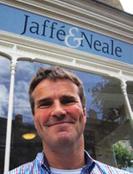During a panel entitled "Printed Books vs. E-books" at the London Book Fair last week, David Taylor, senior v-p of content acquisition for Ingram Content Group, called the notion that print books are dead or dying "complete rubbish." Instead, they co-exist with digital books, and the two formats offer totally different "esthetic experiences," he said.

|
|
| Juckes | |
The panel, moderated by Sarah Juckes of the publishing platform So Completely Novel, also featured Patrick Neale, co-owner of Jaffe & Neale Bookshop and Cafe in Chipping Norton, U.K., and Amanda Renshaw, editorial director at Phaidon Press. It was part of the fair's "Authors HQ" track, meant to provide fledgling and aspiring writers some insight into the industry.
Renshaw agreed that print books are "very much alive and kicking." Although print and digital formats have their own strengths and weaknesses, devices, she said, have proven not great for illustrated material. She went on to present several very high-quality print books published by Phaidon that "you cannot create digitally." And despite the fact that the industry and book supply chains are undeniably changing, she is not pessimistic.

|
|
| Renshaw | |
"People ask me if I'm nervous," Renshaw said. "I'm not. As a publisher and editor, my role is to curate content. It doesn't matter if it's on a page or a screen."
For his part, Neale said he believes that "physical books will be here for a really long time to come," and that e-books are simply another channel through which authors and publishers can reach readers. And with books being ubiquitous, what mattered was the experiences that customers have when buying them. The value of bookshops in today's world, then, comes from providing fantastic experiences that readers cannot find outside of bricks-and-mortar stores, whether they be author events and readings, serendipitous discoveries while browsing, or simply meeting and chatting with booksellers and with other customers.

|
|
| Neale | |
"If you're just interested in getting the cheapest possible books, then okay, there's not a lot I can do," said Neale. But, he continued, he spends a "huge amount of time" finding amazing books to read and making that experience enjoyable. "It's about the experience. We have to work really hard on the experience we give our customers."
Ingram's Taylor also discussed how print books are changing, especially their means of production. The most significant change, he said, was the proliferation of print-on-demand technology. In the past, books that were out of print were effectively dead; print-on-demand is immensely valuable to booksellers in that it is "a great way of keeping books alive." Another result of the spread of print-on-demand is that many traditional publishers are cutting the amount of inventory that they're printing.
 |
|
| Taylor | |
"[Publishers are] beginning to understand that what they have sitting in warehouses is bags of money," Taylor said. Printing books in one country and then shipping them around the world, he added, is no longer necessary; books can be printed on demand in specific markets. And the technology has become sophisticated enough, with full-color, quality print-on-demand books being a reality, that Ingram no longer specifically lists books as available through print-on-demand. "We simply say the book is available."
He also dismissed the idea that eventually print books may be bought only as trophies or fetish items. It would be a "pretty miserable existence," he said, "if people only bought books to hang them on their walls as trophies to their intellectual curiosity." --Alex Mutter

